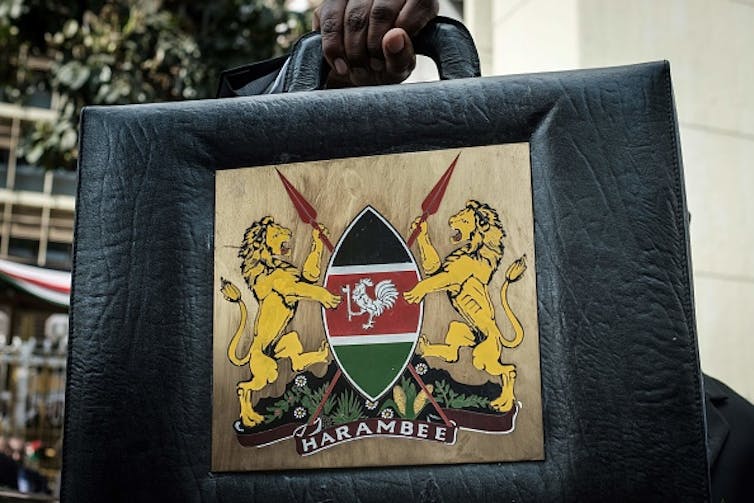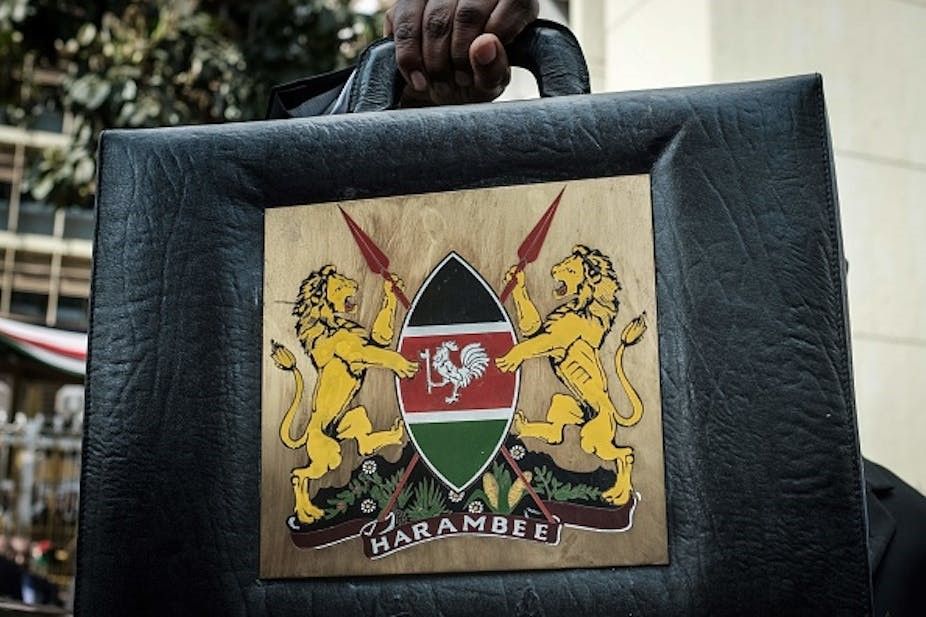 There are fears that Kenya’s debt has been funding mostly government salaries. Yasuyoshi Chiba/AFP via Getty Images
There are fears that Kenya’s debt has been funding mostly government salaries. Yasuyoshi Chiba/AFP via Getty Images
In the run-up to Kenya’s 2022 polls, economic issues, particularly public debt and joblessness, took centre stage. The Kenya Kwanza team led by William Ruto suggested that Kenya had over-borrowed, a habit they pledged to stop. Ruto’s rivals defended the debt, insisting investment in infrastructure would spur economic growth.
Kenya’s overall debt stood at US$87.4 billion, or 72.8% of the GDP by the end of October last year. Almost half of Kenya’s debt, 49.8% (US$43.59 billion) is owed to foreign investors. At an official borrowing limit of KSh10 trillion (US$100 billion), Kenya’s debt-to-GDP ratio would, based on a nominal GDP of US$120 billion in 2021, have been been 83.3%. A debt limit of no more than 64% of the national GDP is recommended for developing countries such as Kenya.
Global institutions like the International Monetary Fund and the World Bank are concerned about Kenya’s debt sustainability.
Aside from the sheer amount being borrowed, there are fears that the debt has been funding recurrent expenditure, mostly government salaries. It’s true, though, that big projects like the standard gauge railway and the expressway have been partly funded by debt.
Debt politics has further been fuelled by the narrative that by saddling Africa with debt, China is able to call the shots on trade, investment and even geopolitical issues.
Ruto is now in power and seems determined to reduce public debt. The government still has to rely on domestic and foreign borrowing, but Ruto wants to reduce it. He intends to do that by collecting more taxes and using national savings to pay for what the country needs.
The Kenya Revenue Authority has been given new revenue targets – US$10 billion more to raise in one year, an almost 50% increase. It is expected to double current collections in five years to US$48 billion by 2027, an election year.
The targets seem too ambitious under the current socio-economic circumstances. In trying to achieve the target, the formal sector is likely to be the hardest hit as its revenues are public and hard to hide. Higher taxes could depress demand too, leading to lower tax revenues and job losses.
What should be done
But increased tax collections could benefit everyone if the taxes are put to good use. Here are seven ways Ruto’s government can raise tax collection and cut reliance on foreign debt:
Focus on economic growth – Tax is charged on income or profit. To meet the target, Ruto should focus on accelerating economic growth. That is how former president Mwai Kibaki – who raised GDP growth to 7% – managed to triple tax revenues, from US$2 billion in 2002 to US$6 billion by 2011.
Of late, economic growth has been lower than expected, and is projected to slow from 5.9% in 2022 to 5.7% in 2023.
The economy grows when we invest or consume more. Ruto should make Kenya a more investment-friendly country by looking at business regulations and laws. Higher taxes eat into investors’ profits and could discourage investment. Kenyan entrepreneurs should be able to start businesses without worrying about the taxman closing their premises.
What encourages economic growth is offering quality goods and services that are globally competitive. The economy should reward innovators and those who go the extra mile. Providing services like roads, sewers, power and security will attract investors. Giving citizens confidence creates demand and economic growth.
Once the economy grows, tax revenue grows, whether it’s value-added tax or income tax. So, before setting a tax revenue target, Kenya should start with an economic growth target like the 10% rate envisaged in Kibaki’s Vision 2030.
Choose optimal tax rates – The government should pick tax rates that yield maximum tax revenue. Theory has it that high tax rates can produce lower tax revenues. High tax rates could lead to inflation as entrepreneurs load the extra charge onto prices. That could lead to lower demand for goods and services, and depress tax revenues.
Share the burden – Have more people pay taxes. That includes the informal sector. If citizens can see how taxes are working for them, they will be encouraged to pay.
Eliminate tax exemptions – There is no need for tax exemptions for investors or firms just because they can lobby the government. Progressive tax rates (high rates for top earners and low ones for smaller incomes) can do all the magic.
Address corruption – About a third of Kenya’s budget is lost through corruption, and former president Uhuru Kenyatta alluded to this.
Boost national savings – Higher savings would reduce interest rates on treasury bonds and bills. Since banks and other institutions would be awash with cash, the government would not need to raise rates to attract investment in government paper. Savings would make credit available to the private sector too, leading to lower interest rates and more borrowing, which is an economic stimulus. The national savings level for Kenya is currently low. The government should craft a policy to help boost savings among households.
Cede roles to philanthropy – Many services being provided by the government could be ceded to philanthropists. Examples include mission hospitals and schools. That would reduce the need for tax revenues. The government should come up with an incentive framework for philanthropists. Additionally, some services currently offered by the government can be offered through the private sector more cheaply and efficiently.
Collecting more tax should be coupled with prudent government spending. That has political implications; it could lead to job losses in the public sector, but create efficiency – which is good for the economy in the long run.
***
Since the article was first published, data on Kenya’s debt statistics in the second paragraph has been updated.
XN Iraki, Associate Professor, Faculty of Business and Management Sciences, University of Nairobi
This article is republished from The Conversation under a Creative Commons license.





